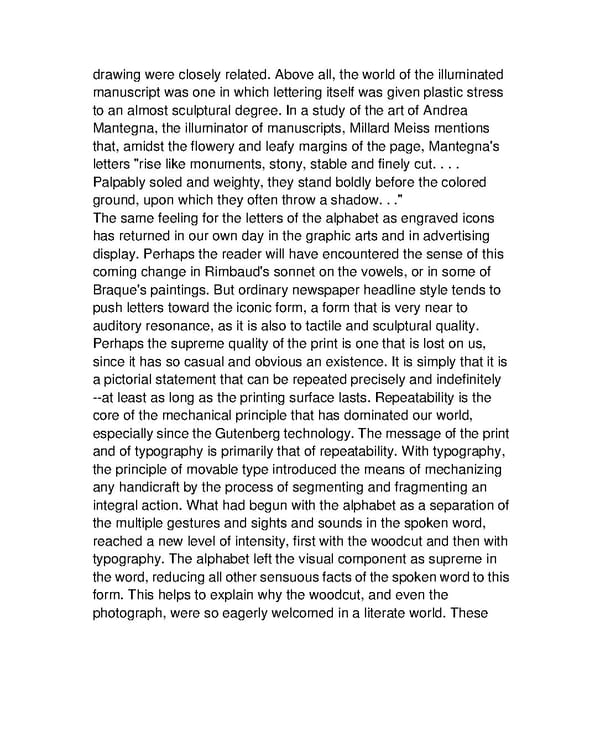drawing were closely related. Above all, the world of the illuminated manuscript was one in which lettering itself was given plastic stress to an almost sculptural degree. In a study of the art of Andrea Mantegna, the illuminator of manuscripts, Millard Meiss mentions that, amidst the flowery and leafy margins of the page, Mantegna's letters "rise like monuments, stony, stable and finely cut. . . . Palpably soled and weighty, they stand boldly before the colored ground, upon which they often throw a shadow. . ." The same feeling for the letters of the alphabet as engraved icons has returned in our own day in the graphic arts and in advertising display. Perhaps the reader will have encountered the sense of this coming change in Rimbaud's sonnet on the vowels, or in some of Braque's paintings. But ordinary newspaper headline style tends to push letters toward the iconic form, a form that is very near to auditory resonance, as it is also to tactile and sculptural quality. Perhaps the supreme quality of the print is one that is lost on us, since it has so casual and obvious an existence. It is simply that it is a pictorial statement that can be repeated precisely and indefinitely --at least as long as the printing surface lasts. Repeatability is the core of the mechanical principle that has dominated our world, especially since the Gutenberg technology. The message of the print and of typography is primarily that of repeatability. With typography, the principle of movable type introduced the means of mechanizing any handicraft by the process of segmenting and fragmenting an integral action. What had begun with the alphabet as a separation of the multiple gestures and sights and sounds in the spoken word, reached a new level of intensity, first with the woodcut and then with typography. The alphabet left the visual component as supreme in the word, reducing all other sensuous facts of the spoken word to this form. This helps to explain why the woodcut, and even the photograph, were so eagerly welcomed in a literate world. These
 Understanding Media by Marshall McLuhan Page 177 Page 179
Understanding Media by Marshall McLuhan Page 177 Page 179